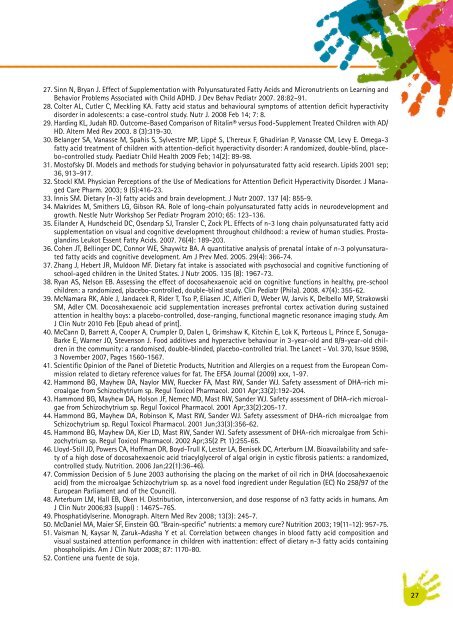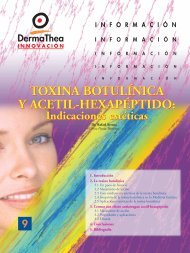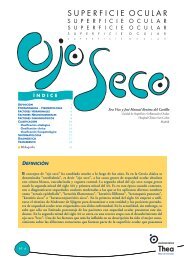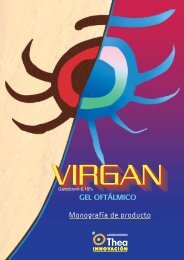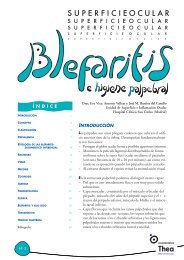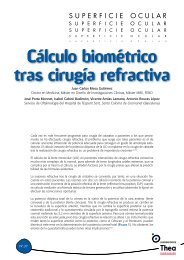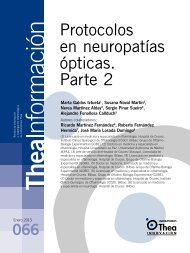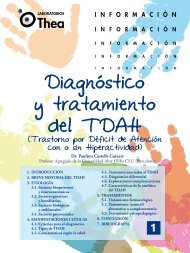Monografía - Laboratorios Thea
Monografía - Laboratorios Thea
Monografía - Laboratorios Thea
You also want an ePaper? Increase the reach of your titles
YUMPU automatically turns print PDFs into web optimized ePapers that Google loves.
27. Sinn N, Bryan J. Effect of Supplementation with Polyunsaturated Fatty Acids and Micronutrients on Learning and<br />
Behavior Problems Associated with Child ADHD. J Dev Behav Pediatr 2007. 28:82–91.<br />
28. Colter AL, Cutler C, Meckling KA. Fatty acid status and behavioural symptoms of attention deficit hyperactivity<br />
disorder in adolescents: a case-control study. Nutr J. 2008 Feb 14; 7: 8.<br />
29. Harding KL, Judah RD. Outcome-Based Comparison of Ritalin® versus Food-Supplement Treated Children with AD/<br />
HD. Altern Med Rev 2003. 8 (3):319-30.<br />
30. Belanger SA, Vanasse M, Spahis S, Sylvestre MP, Lippé S, L’hereux F, Ghadirian P, Vanasse CM, Levy E. Omega-3<br />
fatty acid treatment of children with attention-deficit hyperactivity disorder: A randomized, double-blind, placebo-controlled<br />
study. Paediatr Child Health 2009 Feb; 14(2): 89-98.<br />
31. Mostofsky DI. Models and methods for studying behavior in polyunsaturated fatty acid research. Lipids 2001 sep;<br />
36, 913–917.<br />
32. Stockl KM. Physician Perceptions of the Use of Medications for Attention Deficit Hyperactivity Disorder. J Managed<br />
Care Pharm. 2003; 9 (5):416-23.<br />
33. Innis SM. Dietary (n-3) fatty acids and brain development. J Nutr 2007. 137 (4): 855-9.<br />
34. Makrides M, Smithers LG, Gibson RA. Role of long-chain polyunsaturated fatty acids in neurodevelopment and<br />
growth. Nestle Nutr Workshop Ser Pediatr Program 2010; 65: 123-136.<br />
35. Eilander A, Hundscheid DC, Osendarp SJ, Transler C, Zock PL. Effects of n-3 long chain polyunsaturated fatty acid<br />
supplementation on visual and cognitive development throughout childhood: a review of human studies. Prostaglandins<br />
Leukot Essent Fatty Acids. 2007. 76(4): 189-203.<br />
36. Cohen JT, Bellinger DC, Connor WE, Shaywitz BA. A quantitative analysis of prenatal intake of n-3 polyunsaturated<br />
fatty acids and cognitive development. Am J Prev Med. 2005. 29(4): 366-74.<br />
37. Zhang J, Hebert JR, Muldoon MF. Dietary fat intake is associated with psychosocial and cognitive functioning of<br />
school-aged children in the United States. J Nutr 2005. 135 (8): 1967-73.<br />
38. Ryan AS, Nelson EB. Assessing the effect of docosahexaenoic acid on cognitive functions in healthy, pre-school<br />
children: a randomized, placebo-controlled, double-blind study. Clin Pediatr (Phila). 2008. 47(4): 355-62.<br />
39. McNamara RK, Able J, Jandacek R, Rider T, Tso P, Eliasen JC, Alfieri D, Weber W, Jarvis K, Delbello MP, Strakowski<br />
SM, Adler CM. Docosahexaenoic acid supplementation increases prefrontal cortex activation during sustained<br />
attention in healthy boys: a placebo-controlled, dose-ranging, functional magnetic resonance imaging study. Am<br />
J Clin Nutr 2010 Feb [Epub ahead of print].<br />
40. McCann D, Barrett A, Cooper A, Crumpler D, Dalen L, Grimshaw K, Kitchin E, Lok K, Porteous L, Prince E, Sonuga-<br />
Barke E, Warner JO, Stevenson J. Food additives and hyperactive behaviour in 3-year-old and 8/9-year-old children<br />
in the community: a randomised, double-blinded, placebo-controlled trial. The Lancet - Vol. 370, Issue 9598,<br />
3 November 2007, Pages 1560-1567.<br />
41. Scientific Opinion of the Panel of Dietetic Products, Nutrition and Allergies on a request from the European Commission<br />
related to dietary reference values for fat. The EFSA Journal (2009) xxx, 1-97.<br />
42. Hammond BG, Mayhew DA, Naylor MW, Ruecker FA, Mast RW, Sander WJ. Safety assessment of DHA-rich microalgae<br />
from Schizochytrium sp. Regul Toxicol Pharmacol. 2001 Apr;33(2):192-204.<br />
43. Hammond BG, Mayhew DA, Holson JF, Nemec MD, Mast RW, Sander WJ. Safety assessment of DHA-rich microalgae<br />
from Schizochytrium sp. Regul Toxicol Pharmacol. 2001 Apr;33(2):205-17.<br />
44. Hammond BG, Mayhew DA, Robinson K, Mast RW, Sander WJ. Safety assessment of DHA-rich microalgae from<br />
Schizochytrium sp. Regul Toxicol Pharmacol. 2001 Jun;33(3):356-62.<br />
45. Hammond BG, Mayhew DA, Kier LD, Mast RW, Sander WJ. Safety assessment of DHA-rich microalgae from Schizochytrium<br />
sp. Regul Toxicol Pharmacol. 2002 Apr;35(2 Pt 1):255-65.<br />
46. Lloyd-Still JD, Powers CA, Hoffman DR, Boyd-Trull K, Lester LA, Benisek DC, Arterburn LM. Bioavailability and safety<br />
of a high dose of docosahexaenoic acid triacylglycerol of algal origin in cystic fibrosis patients: a randomized,<br />
controlled study. Nutrition. 2006 Jan;22(1):36-46).<br />
47. Commission Decision of 5 June 2003 authorising the placing on the market of oil rich in DHA (docosahexaenoic<br />
acid) from the microalgae Schizochytrium sp. as a novel food ingredient under Regulation (EC) No 258/97 of the<br />
European Parliament and of the Council).<br />
48. Arterburn LM, Hall EB, Oken H. Distribution, interconversion, and dose response of n3 fatty acids in humans. Am<br />
J Clin Nutr 2006;83 (suppl) : 1467S–76S.<br />
49. Phosphatidylserine. Monograph. Altern Med Rev 2008; 13(3): 245-7.<br />
50. McDaniel MA, Maier SF, Einstein GO. “Brain-specific” nutrients: a memory cure? Nutrition 2003; 19(11-12): 957-75.<br />
51. Vaisman N, Kaysar N, Zaruk-Adasha Y et al. Correlation between changes in blood fatty acid composition and<br />
visual sustained attention performance in children with inattention: effect of dietary n-3 fatty acids containing<br />
phospholipids. Am J Clin Nutr 2008; 87: 1170-80.<br />
52. Contiene una fuente de soja.<br />
27


